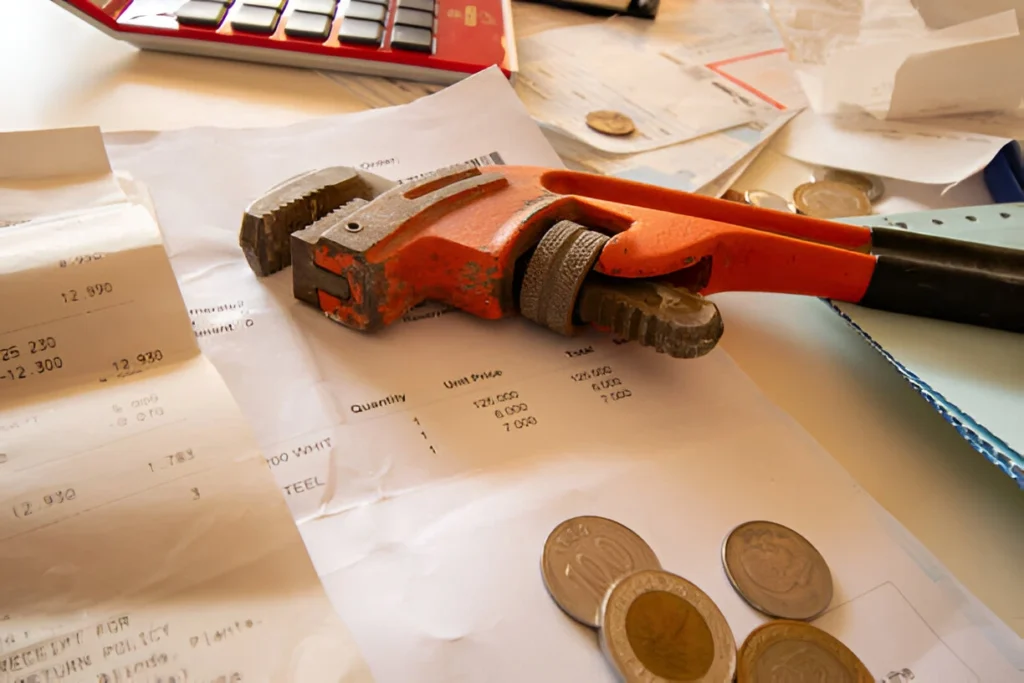Here at Behind Decor, we love talking about beautiful interiors. But the truth is, no amount of shiplap or statement lighting can fix a problem that starts beneath your feet. If your floors are sloping, cracks are snaking up your walls, or doors suddenly won’t close, you might be facing a foundation issue. And that often leads to one daunting word: underpinning.
The biggest question that follows is, “How much does underpinning cost?” It’s the natural first step for any homeowner staring down a potentially massive repair bill. The short answer is: it’s complicated. The price isn’t a one-size-fits-all figure like a gallon of paint; it’s more like the cost of a custom-built piece of furniture, highly dependent on your specific situation.
In this comprehensive guide, we’ll pull back the curtain on all the factors that determine the final price tag for underpinning. We’ll translate contractor-speak into plain English, explore the different methods available, and help you understand what you’re really paying for. By the end, you’ll be equipped with the knowledge to navigate this process confidently.
Why Underpinning Isn’t a DIY Project (And Why Cost Varies So Wildly)
Before we dive into the numbers, let’s be clear: underpinning is a major structural engineering procedure. It involves excavating beneath your existing foundation to strengthen and stabilize it, essentially giving your home a new, deeper base. This is not the time to break out the shovel and watch a few YouTube tutorials. This is a job for licensed, insured, and highly experienced professionals.
The reason the cost of underpinning is so variable boils down to one simple concept: every home and every soil problem is unique. It’s like asking, “How much does surgery cost?” Without knowing the procedure, the complexity, and the patient’s specific needs, an accurate quote is impossible.
Breaking Down the Cost: How Much Does Underpinning Cost on Average?
Let’s get to the numbers you came for. Based on industry data from sources like Angi and national contractors, the average cost to underpin a foundation in the United States typically falls within a wide range.
- National Average Cost: $1,000 – $2,500 per pier
- Total Project Average: $5,000 – $30,000+
- Minor/Small Projects: Can range from $4,000 to $8,000 for a single problematic area.
- Major/Whole-House Projects: Can easily soar to $40,000, $80,000, or even more for large homes with complex, deep-seated issues.
These figures are a starting point. To understand where your project might land, we need to dissect the key factors that contractors use to build their estimates.
Key Factor 1: The Method of Underpinning
The technique used is the single biggest driver of cost. Here are the most common methods:
Mass Pour Concrete (The Traditional Method):
This is the classic approach. Workers excavate sections (“pins”) beneath the foundation in stages and fill them with concrete. It’s labor-intensive but very reliable.
- Cost Implication: Often on the lower end of the per-pier cost spectrum, but it requires more manual labor and time.
Screw Piles (Helical Piers) or Steel Piers:
These are steel shafts that are screwed or driven deep into the stable soil or bedrock beneath your home. The foundation is then hydraulically lifted and secured to these piers.
- Cost Implication: Generally more expensive per pier ($1,500 – $3,000+) as they involve specialized equipment and materials. However, they are often faster to install and can reach greater depths, making them ideal for certain soil types.
Resin Injection (Polyurethane Foam Jacking):
A less invasive method where a two-part expanding polymer resin is injected through small holes in the foundation. As it expands, it lifts sunken concrete slabs and compacts the soil beneath.
- Cost Implication: Typically the cheapest option ($5 – $25 per square foot), but it’s not a true “underpinning” solution for major structural failures. It’s best for lifting settled slabs, sidewalks, or minor leveling, not for rebuilding a compromised foundation.
Key Factor 2: Depth and Scope of the Project
How deep do they need to go to find stable soil? How much of your foundation needs work?
- Depth: The deeper the excavation, the more materials and labor are required. Costs can increase significantly for every additional foot of depth.
- Number of Piers: A single cracked corner might need 4-6 piers. A whole-house settlement could require 20+.
- Linear Feet: Contractors often price based on the linear footage of the wall that needs work. You might see a price of $350 – $600 per linear foot.
Key Factor 3: Accessibility and Site Conditions
Is your house on a steep slope? Is there a giant oak tree two feet from the foundation? Can a large excavator easily get to the work site?
- Tight Spaces: Limited access can require more manual labor or specialized mini-equipment, increasing costs.
- Landscaping: Be prepared for the cost of removing and later reinstating decks, patios, sprinkler systems, or prized gardens that are in the way.
- Soil Type: Hard, rocky soil is more difficult and expensive to excavate than soft sand.
Key Factor 4: The Invisible Costs (The “Oh, Right…” Factors)
When budgeting for how much underpinning costs, you must remember the ancillary expenses.
- Engineering Report: Most jurisdictions require a permit, which requires a plan stamped by a structural engineer. This can cost $500 – $2,000.
- Building Permits: The permit fees themselves, usually a percentage of the project cost.
- Interior Repairs: Remember those cracked walls and sloping floors? Underpinning stabilizes the foundation, but it doesn’t magically fix the drywall, tile, or molding upstairs. Budget for cosmetic repairs after the structural work is complete.
- Unexpected Issues: Once they start digging, contractors might discover rotten footer boards, water drainage issues, or other surprises that need to be addressed, potentially increasing the project scope and cost.
The Underpinning Process: What You’re Actually Paying For
Understanding the process helps you see the value behind the invoice. It typically follows these steps:
- Inspection & Engineering Assessment: The problem is diagnosed, and a solution is engineered.
- Excavation: Trenches are dug along the foundation to expose the footers.
- Installation: Piers are installed, or concrete is poured in sections.
- Hydraulic Lifting (if needed): The foundation is carefully raised back to its original position.
- Backfilling & Clean-up: The excavated areas are filled back in, and the site is cleaned.
- Inspection: The work is inspected for compliance with the engineering plan.
- Interior Repair: You repair the cosmetic damage inside your home.
Real-World Scenarios: What Might This Actually Look Like?
- Scenario 1: The Cracking Corners. A homeowner in Texas notices significant cracking where one corner of their 1,500 sq ft. The ranch home has settled due to clay soil contraction. The engineer specifies 6 helical piers installed to a depth of 15 feet.
- Estimated Cost: 6 piers x $1,800/piers = $10,800 + engineering ($1,000) + permits ($300) = ~$12,100
- Estimated Cost: 6 piers x $1,800/piers = $10,800 + engineering ($1,000) + permits ($300) = ~$12,100
- Scenario 2: The Whole-House Lift. A century-old home in Ohio has suffered from gradual, uneven settlement across its entire front façade. The solution requires 16 linear feet of mass pour concrete underpinning and hydraulic lifting.
- Estimated Cost: 16 ft. x $450/linear foot = $7,200 + engineering ($1,500) + permits ($400) + interior drywall/plaster repair ($3,000) = ~$12,100
- Estimated Cost: 16 ft. x $450/linear foot = $7,200 + engineering ($1,500) + permits ($400) + interior drywall/plaster repair ($3,000) = ~$12,100
- Scenario 3: The Slab Lift. A homeowner in Arizona has a garage slab that has sunk 3 inches, creating a tripping hazard and water drainage issues. They opt for resin injection.
- Estimated Cost: 400 sq ft. slab x $10/sq.ft. = $4,000
Frequently Asked Questions (FAQs) with Behind Decor
Does homeowners' insurance cover underpinning?
Typically, no. Most policies exclude foundation damage from settling or soil movement unless caused by a specific covered peril.
How long does underpinning take?
The physical work often takes 3-7 days, but the entire process from engineering to cleanup can take several weeks.
Is it underpinning a permanent fix?
Yes, when performed correctly by a professional, underpinning is designed to be a permanent structural solution.
How do I find a good contractor?
Seek specialized, licensed, and insured foundation repair companies with strong reviews and who provide detailed warranties.
What’s the biggest cost factor?
The method used (e.g., piers vs. concrete) and the depth/scope of the repair are the primary cost drivers.
Conclusion: An Investment in Your Home’s Future
As the team at Behind Decor, we believe a beautiful home is a safe and sound one. While the question “how much does underpinning cost?” doesn’t have a simple answer, we hope this guide has demystified the factors involved. It’s a significant investment, but it’s an investment in the very core of your largest asset. It’s the unglamorous, behind-the-scenes work that ensures your home stands strong for decades to come, allowing you to focus on the fun part, making it beautiful on the inside.
The first step is always to get multiple detailed quotes from qualified foundation specialists. They can give you a precise number and a clear plan to restore your peace of mind and your home’s structural integrity.




